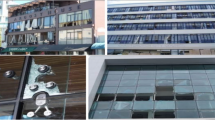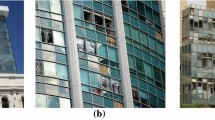Abstract
Point-supported glass panels are frequently used for façades systems due to their preferred visual and aesthetics character. These glazing systems are subjected to various static and dynamic loads during the lifetime of a structure. For example, in earthquake prone areas, the glazing systems may be exposed to seismic forces that have been already observed to induce critical damages. The current paper presents a simplified FE-based method to estimate the failure of such point-supported glass panels in case of both single and multiple load events. As an example, the damage induced by a single seismic event is investigated by the current paper that focuses also on the cumulative effect on the glass strength due to a series of earthquakes recorded in California between 1992 and 2010. The proposed method uses a global FE model to estimate the earthquake-induced force time-histories that, then, can be applied for a more detailed sub-model of the local part of the glass in question, including the hole. Subdividing the stresses around the hole into sections allows for a final analysis using the well known model for static fatigue in glass to estimate the damage. The latter enables the calculation of both the short and long-term capacity of the point-supported glass panels that, eventually, leads to the prediction of the remaining life-time of the structure exposed to multiple seismic excitations. From the provided example, it is clearly demonstrated that fully tempered glass is superior for such seismic events. However, the proposed model is generic and may be applied to other type of forces, e.g., related to wind and gravity loads.










Similar content being viewed by others
Notes
Glass experiences a reduction in strength over time, even with a static load. This phenomenon is known as static fatigue.
It should be noted that the inert strength of 78 MPa is chosen in such a way that damage (without failure of the glass) can be studied for the glass in later examples.
According to NEHRP (National Earthquake Hazards Reduction Program) soil classification, Class C corresponds to very dense soil and soft rock with average shear wave velocity to a depth of 30 m between 360 and 760 m/s.
The moment magnitude \(M_w\) is one of the most common quantitative measure of an earthquake’s size. It is dimensionless and accounts for the total amount of energy released during an earthquake.
Considering the highly dynamic nature of the seismic load, it is reasonable to compare the peak of the stress history to the inert glass strength. It is assumed then that the glass strength is constant for loading times shorter than 0.01 s and equal to the inert strength, as shown in Fig. 1, even though recent results state otherwise, see e.g., Meyland et al. (2021).
Fully tempered glass is omitted from the investigation due to its high residual compressive stresses limiting the damage accumulated.
It should also be remembered that the threshold value of 7.5 MPa is based on the remaining residual stresses in annealed glass and should de facto be added to the value of 25 MPa.
References
Baird, A., Palermo, A., Pampanin, S.: Facade damage assessment of multi-storey buildings in the 2011 Christchurch earthquake. Bull. N. Z. Soc. Earthq. Eng. 44(4), 368–376 (2011)
Beason, W.L., Morgan, J.R.: Glass failure prediction model. J. Struct. Eng. 110(2), 197–212 (1984)
Bedon, C., et al.: Performance of structural glass facades under extreme loads: design methods, existing research, current issues and trends. Constr. Build. Mater. 163, 921–937 (2018)
Bedon, C., Amadio, C.: Enhancement of the seismic performance of multi-storey buildings by means of dissipative glazing curtain walls. Eng. Struct. 152, 320–334 (2017)
Bedon, C., Fasan, M., Amadio, C.: Vibration analysis and dynamic characterization of structural glass elements with different restraints based on operational modal analysis. Buildings 9(1), 1–23 (2019)
Behr, R.A.: Design of architectural glazing to resist earthquakes. J. Archit. Eng. 12(3), 122–128 (2006)
Behr, R.A.: Architectural Glass to Resist Seismic and Extreme Climatic Events, 1st edn., p. 260. Elsevier, Oxford (2009)
Behr, R.A., Belarbi, A.: Seismic test methods for architectural glazing systems. Earthq. Spectra 12(1), 129–143 (1996)
Bouwkamp, J.G., Meehan, J. F.: Drift limitations imposed by glass. In: Proceedings of the Second World Conference on Earthquake Engineering (July 11–18, 1960), pp. 1763–1778. Tokyo, Japan (1960)
Charleson, A.: Seismic Design for Architects, Outwitting the Quake, 1st edn., p. 281. Elsevier, Oxford (2008)
Chiou, B., Darragh, R., Gregor, N., Silva, W.: NGA project strong-motion database. Earthq. Spectra 24(1), 23–44 (2008)
Earthquake Engineering Research Institute (EERI). Loma Prieta earthquake reconnaissance report. Earthquake Spectra, suppl. to Vol. 6, Oakland, CA. Research Report (1990)
Earthquake Engineering Research Institute (EERI). Northridge Earthquake Reconnaissance Report, vol. 1. Earthquake Spectra, suppl. C to Vol. 11, Oakland, CA. Research Report (1995a)
Earthquake Engineering Research Institute (EERI). The Hyogo-Ken Nanby Earthquake, January 17, 1995, Preliminary Reconnaissance Report. EERI 95-04 , Oakland, CA. Research Report (1995b)
Earthquake Engineering Research Institute (EERI). The Nisqually, Washington, Earthquake, February 28, 2001, Preliminary Reconnaissance Report. EERI 2001-01, Oakland CA. Research Report (2001)
EN 1998: Eurocode 8: Design of structures for earthquake resistance - Part 1: General rules, seismic actions and rules for buildings. Eng. (2005)
Evans, D., Ramirez, F.J. L.: Glass Damage in the 19 September 1985 Mexico Earthquake. In: Lessons Learned from the 1985 Mexico Earthquake. Reducing earthquake hazards. In: Proceedings of 3rd U.S.–Mexico Workshop on 1985 Mexico Earthquake Research (March 16–18, 1989), pp. 234–236. Mexico City, Mexico (1985)
Gates, W.E., McGavin, G.: Lessons learned from the 1994 Northridge earthquake on the vulnerability of nonstructural systems. In: ATC-29-1 Proceedings of the Eighth World Conference on Earthquake Engineering (1984), pp. 93–106 . Applied Technology Council, Redwood City, CA (1998)
Gehrke, E., Haehnert, M., Ullner, C.: Strength and fatigue of some binaru and ternary silicate glasses. J. Non-Crystal. Solids 80(1), 269–276 (1986)
Gowda, B., Heydari, N.: High displacement glass seismic systems. Pract. Period. Struct. Des. Constr. 15(2), 170–176 (2010)
Haldimann, M., Luible, A., Overend, M.: Structural use of glass. Ed. by International Association for Bridge and Structural Engineering. IABSE-AIPC-IVBH, Zurich (2008)
Hancock, J., Bommer, J.J., Stafford, P.J.: Numbers of scaled and matched accelerograms required for inelastic dynamic analyses. Earthq. Eng. Struct. Dyn. 37(14), 1585–1607 (2008). https://doi.org/10.1002/eqe.827
Holmes, J.D.: Wind action on glass and Brown’s integral. Eng. Struct. 7(7), 226–230 (1985)
Housner, G.W., Jennings, P.C.: The San Fernando California earthquake. Earthq. Eng. Struct. Dyn. 1, 5–31 (1972)
Inca, E., Jordão, S., Rebelo, C., Rigueiro, C., Simões, R.: Seismic behaviour of point fixed glass façade systems: state of the art review. Eur. J. Eng. Sci. Technol. 2(2), 1–15 (2019)
Lingnell, A.W.: Initial survey and audit of glass and glazing system performance during the earthquake in the Los Angeles area on January 17, 1994. Research Report Final report submitted to Primary Glass Manufacturers Council, Lingnell Consulting Services (1994)
MacLeod, F. A.: The latest developments in seismic mitigation of suspended ceiling systems. In: 13th World Conference on Earthquake Engineering (August 1–6, 2004). Ed. by 13 WCEE Secretariat. Vancouver, B.C., Canada: 13 WCEE Secretariat (2004)
Mattei, S., Fasan, M., Bedon, C.: On the use of cloud analysis for structural glass members under seismic events. Sustainability (Switzerland) 13(16), 9291 (2021). https://doi.org/10.3390/su13169291
Memari, A.M.: Design of curtain walls for earthquake-induced loads and drifts. ASCE Man. Rep. Eng. Pract. 1(126), 105–128 (2013)
Memari, A.M., Behr, R.A., Kremer, P.A.: Seismic behavior of curtain walls containing insulating glass units. J. Archit. Eng. 9(2), 70–85 (2003)
Meyland, M.J., Nielsen, J.H., Kocer, C.: Tensile behaviour of soda-lime-silica glass and the significance of load duration: a literature review. J. Build. Eng. 44, 102966 (2021). https://doi.org/10.1016/j.jobe.2021.102966
Mould, R.E.: Strength and static fatigue of abraded glass under controlled ambient conditions: IV. Effect of surrounding medium. J. Am. Ceram. Soc. 44(10), 481–491 (1961)
Nielsen, J.H.: Tempered Glass. Bolted Connections and Related Problems. Ph.D. Thesis. Technical University of Denmark, Copenhagen (2011)
Nielsen, J.H., Olesen, J.F., Poulsen, P.N.: Simulation of residual stresses at holes in tempered glass: a parametric study. Mater. Struct. 43(7), 947–961 (2010). https://doi.org/10.1617/s11527-009-9558-z
Overend, M.: The appraisal of structural glass assemblies. Ph.D. Thesis. University of Surrey, Guildford (2002)
Pantelides, C.P., Behr, R.A., Truman, K.Z.: Development of a loading history for seismic testing of architectural glass in a shop-front wall system. Eng. Struct. 18(12), 917–935 (1996)
Reitherman, B., et al.: Non structural damage. Earthq. Spectra 11(S2), 453–514 (1995)
Ryan, P., Otlet, M., Ogden, R.G.: Steel Supported Glazing Systems, 1st edn., p. 74. Steel Construction Institute, Ascot, Berkshire (1997)
Sakamoto, I., Itoh, H., Ohashi, Y.: Proposals for aseismic design method on nonstructural elements. In: Proceedings of the Eighth World Conference on Earthquake Engineering, pp. 1093–1100. San Francisco, California (1984)
Sglavo, V.M., Green, D.J.: Threshold stress intensity factor in soda-lime silicate glass by interrupted static fatigue test. J. Eur. Ceram. Soc. 16(6), 645–651 (1996)
Shand, E.B.: Experimental study of fracture of glass: I: The fracture process. J. Am. Ceram. Soc. 37(2), 52–59 (1954)
Sivanerupan, S.: In-plane seismic performance of glass façade systems. Ph.D. Thesis. Melbourne: Swinburne University of Technology, Melbourne, Australia (2011)
Sivanerupan, S., Wilson, J., Gad, E., Lam, N.: Drift performance of point fixed glass façade systems. Adv. Struct. Eng. 17(10), 1481–1495 (2014)
Sucuoǧlu, Haluk, Girija Vallabhan, C.V.: Behaviour of window glass panels during earthquakes. Eng. Struct. 19(8), 685–694 (1997)
Watson, J., Nielsen, J., Overend, M.: A critical flaw size approach for predicting the strength of bolted glass connections. Eng. Struct. 57, 87–99 (2013). https://doi.org/10.1016/j.engstruct.2013.07.026
Author information
Authors and Affiliations
Corresponding author
Ethics declarations
Conflicts of interest
On behalf of all authors, the corresponding author states that there is no conflict of interest.
Additional information
Publisher's Note
Springer Nature remains neutral with regard to jurisdictional claims in published maps and institutional affiliations.
Rights and permissions
Springer Nature or its licensor (e.g. a society or other partner) holds exclusive rights to this article under a publishing agreement with the author(s) or other rightsholder(s); author self-archiving of the accepted manuscript version of this article is solely governed by the terms of such publishing agreement and applicable law.
About this article
Cite this article
Sciacca, G., Katsanos, E. & Nielsen, J.H. Damage accumulation in point supported glass panels subjected to earthquake excitations via a simplified stepwise approach. Glass Struct Eng 7, 661–679 (2022). https://doi.org/10.1007/s40940-022-00215-8
Published:
Issue Date:
DOI: https://doi.org/10.1007/s40940-022-00215-8




